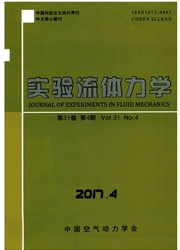

 中文摘要:
中文摘要:
发动机燃烧流场温度的准确实时诊断对研究燃烧机理、提高燃烧效率及降低污染物排放等至关重要。分析了TDLAS技术二次谐波法免标定测温原理,实现了利用该技术对直联式超燃冲压发动机燃烧室内部温度的在线测量,并采用电控平移台扫描的方式实现了发动机出口与扩张段温度随空间变化的测量。结果表明该发动机燃烧特性主要有:(1)发动机出口与扩张段,氢气与乙烯两种燃料燃烧状况基本相同,且随着沿y轴自下往上扫描,温度逐渐升高;(2)发动机燃烧室内,氢气燃烧时的温度比乙烯燃烧时的温度要高和稳定;氢气燃烧过程温度基本处于2100K左右,乙烯从点火至燃烧结束温度从2000K左右逐渐降至1250K左右。TDLAS技术在复杂燃烧环境下的工程应用表明该技术具有抗干扰能力强、数据处理速度快的优点,可用于研制发动机燃烧场温度在线监测传感器。
 英文摘要:
英文摘要:
Accurate and real-time diagnostics of engine combustion is critical to understand combustion processes,improve combustion efficiency and reduce the production of pollutants. The development and demonstration of tunable diode laser absorption spectroscopy (TDLAS)for temperature measurements of supersonic flow are presented in this paper.The thermometry of calibration-free method for TDLAS second harmonic technique is introduced,and the temperature is measured using two water vapor absorption lines near 1398nm.The performance of TDLAS system is validated in a calibration burner at temperatures between 600K to 1400K,and the max discrepancy is 22K below the temperature of 1000K.Experiments were conducted on a direct-connect supersonic engine,and the on-line measurement of temperature was realized.In the en-gine exit and expansion section,the spatial variations of temperatures of ethylene and hydrogen were measured via an automatic platform to control the TDLAS system.In the engine combus-tor,the temporal variations of temperatures at a fixed position of ethylene and hydrogen were measured.The main measurement results of this engine are as follows:(1 )In the engine exit and expansion section,the combustion temperatures of hydrogen and ethylene are nearly identi-cal,and along the y axis scan from bottom to top,the temperatures of both fuels increase gradu-ally.The max temperatures at the engine exit and expansion section are about 1600K and 2250K, respectively;(2)In the engine combustor,the combustion temperature of hydrogen is higher and more stable than that of ethylene.The temperature of hydrogen combustion process is about 2100K,while the temperature of ethylene combustion process decreases from 2000K to about 1250K gradually.These engineering applications show that non-intrusive,fast data processing, on-line measurements can be made in harsh environments using the calibration-free TDLAS tech-nique,and illustrate the potential of their use to develop practical TDLAS sensors for a wide vari-ety of indu
 同期刊论文项目
同期刊论文项目
 同项目期刊论文
同项目期刊论文
 期刊信息
期刊信息
